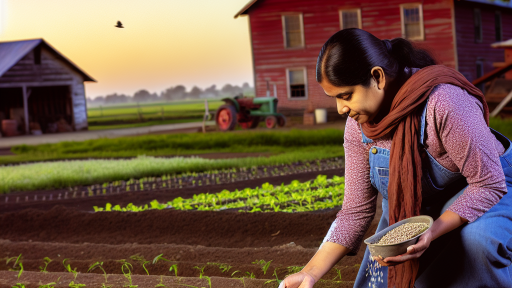Introduction to Sustainable Farm Pathways
Definition of Sustainable Farm Pathways
Sustainable farm pathways refer to routes and practices promoting eco-friendly agriculture.
They emphasize minimizing environmental impacts and enhancing resource efficiency.
Additionally, these pathways support the health of ecosystems and communities.
Importance of Sustainable Farm Pathways
Sustainable farm pathways play a crucial role in combating climate change.
They improve soil health by reducing erosion and increasing organic matter.
Moreover, these practices enhance water quality by limiting runoff and pollution.
They also promote biodiversity by creating habitats for various species.
Supporting Local Economies
Implementing sustainable pathways benefits local communities economically.
They create jobs through sustainable practices and agroecological innovations.
Local farmers can access new markets for organic and sustainable products.
Enhancing Food Security
Sustainable pathways contribute to food security through diversified crops.
They help communities become more resilient against climate-related challenges.
Furthermore, these practices ensure long-term access to nutritious food.
Key Principles of Sustainable Access Planning in Agriculture
Prioritizing Environmental Integrity
Sustainable access planning emphasizes environmental integrity.
This principle aims to reduce degradation of natural resources.
Transform Your Agribusiness
Unlock your farm's potential with expert advice tailored to your needs. Get actionable steps that drive real results.
Get StartedHealthy ecosystems are essential for agricultural success.
Practices should enhance soil health and biodiversity.
Implementing erosion control measures is crucial.
Furthermore, using native vegetation helps restore habitats.
Enhancing Social Equity
Social equity is a cornerstone of sustainable access planning.
Farmers must ensure fair access to agricultural resources.
This approach supports local communities and smallholder farmers.
Active participation in decision-making is vital.
Additionally, access to training and resources is essential.
A focus on gender equality promotes diverse perspectives.
Improving Economic Viability
Economic viability drives the success of sustainable access planning.
Farmers must implement cost-effective solutions for access.
This includes developing infrastructure that reduces expenses.
Utilizing renewable resources can lead to long-term savings.
Moreover, creating markets for sustainable products boosts income.
Collaborative efforts among farmers can enhance economic resilience.
Implementing Adaptive Management Strategies
Adaptive management facilitates responsive planning in agriculture.
This approach allows for dynamic changes based on evaluation.
Data collection and analysis inform better decision-making.
Innovative technologies support adaptive practices.
Farmers can respond quickly to environmental shifts.
Agility enhances the sustainability of agricultural pathways.
Building Strong Community Relationships
Community relationships are foundational to successful access planning.
Engaging local stakeholders fosters collective responsibility.
Showcase Your Farming Business
Publish your professional farming services profile on our blog for a one-time fee of $200 and reach a dedicated audience of farmers and agribusiness owners.
Publish Your ProfileRegular communication ensures transparency and trust.
Collaborative projects can enhance resource-sharing opportunities.
Additionally, fostering community stewardship protects local ecosystems.
Ultimately, strong relationships support overall agricultural sustainability.
Assessing Farm Site Conditions for Optimal Pathway Design
Understanding Site Topography
Begin by analyzing the land’s topography.
Identify slopes, flat areas, and any depressions.
These features influence water drainage and access routes.
Utilize topographical maps or digital tools for accurate data.
Evaluating Soil Quality
Soil assessment is crucial for sustainable planning.
Test soil composition for nutrients and drainage capabilities.
Consider using a combination of home testing kits and lab services.
Good soil quality ensures the longevity of built pathways.
Assessing Weather Patterns
Review historical climate data for the location.
Understand seasonal variations in weather and precipitation.
This knowledge will guide materials selection and design features.
Choose weather-resistant solutions to enhance durability.
Identifying Existing Vegetation
Document the types of vegetation already present on-site.
Evaluate how these plants contribute to the landscape.
Preserving native species will support local ecosystems.
Furthermore, consider pathways that avoid disrupting established plants.
Utilizing Local Resources
Leverage local materials for construction wherever possible.
This practice reduces transportation emissions and costs.
For example, regional stones or timber may prove beneficial.
In addition, sourcing locally enhances community involvement.
Creating a Pathway Network Plan
Develop a comprehensive pathway network for the farm.
Plan access routes that connect essential areas effectively.
Include pathways for both machinery and foot traffic.
Flexibility in the plan allows for future adaptations.
Incorporating Sustainability Practices
Design pathways with sustainable practices in mind.
Consider permeable materials to reduce soil compaction.
Implement rain gardens or swales along pathways to manage runoff.
Ultimately, sustainable pathways support overall farm productivity.
Delve into the Subject: Enhancing Crop Yields Through Biodiversity
Integration of Renewable Energy Sources in Farm Pathway Planning
Importance of Renewable Energy
Renewable energy sources play a crucial role in sustainable farming.
They reduce reliance on fossil fuels while lowering greenhouse gas emissions.
Using renewable energy enhances farm profitability over time.
Types of Renewable Energy Sources
Farmers can consider several renewable energy options for their operations.
Solar energy is one of the most accessible and cost-effective sources.
Wind energy can also provide significant savings on electricity costs.
Biomass energy utilizes agricultural waste, contributing to waste reduction.
Showcase Your Farming Business
Publish your professional farming services profile on our blog for a one-time fee of $200 and reach a dedicated audience of farmers and agribusiness owners.
Publish Your ProfileAdditionally, geothermal systems can increase heating efficiency for farms.
Integrating Renewable Energy into Farm Pathways
A well-planned approach maximizes the benefits of renewable energy.
First, assess the energy needs of the farm comprehensively.
Next, analyze local renewable energy resources available.
Consider all aspects, including resource availability and seasonal variations.
Then, design pathways that incorporate energy-efficient technologies.
Understanding Financial Incentives
Various government programs encourage renewable energy adoption.
Farmers may qualify for tax credits, loans, or grants.
These incentives can ease the initial financial burden of transitioning.
Monitoring and Maintenance
Regular monitoring ensures that renewable systems operate efficiently.
Establish a maintenance schedule for all renewable energy equipment.
This approach prevents costly downtimes and extends equipment lifespan.
Evaluate energy usage periodically to identify areas for improvement.
Connecting with Local Resources
Farmers should collaborate with local energy experts for guidance.
Establish partnerships with renewable energy companies for support.
Joining local agricultural cooperatives can provide valuable resources.
Collectively, farmers can negotiate better rates and services.
Explore Further: Conservation Tillage Practices to Preserve Soil Moisture
Environmental Impact Assessment: How to Minimize Ecological Footprint
Importance of Environmental Impact Assessments
Environmental impact assessments play a crucial role in sustainable farming.
They help identify potential ecological risks associated with farming practices.
Furthermore, these assessments guide farmers in making informed decisions.
Analyzing Ecological Footprints
Start by examining current farming techniques and their impacts.
A detailed analysis helps to pinpoint specific areas for improvement.
Consequently, farmers can develop strategies to reduce ecological footprints.
Key Components to Consider
Evaluate land use and its effects on local ecosystems.
Analyze water usage and the potential for conservation.
Assess soil health and the implications of farming practices.
Finally, consider biodiversity and ways to enhance it within farming operations.
Implementing Sustainable Practices
Transitioning to more sustainable methods can greatly reduce impact.
Utilize crop rotation to improve soil health and reduce pest cycles.
Incorporate cover cropping to enhance soil nutrients and prevent erosion.
Additionally, adopt integrated pest management to minimize chemical use.
Collaborative Approaches
Engaging with local conservation groups can enhance sustainability efforts.
Collaboration can lead to shared resources and knowledge exchange.
Participating in community initiatives further supports sustainable goals.
Monitoring and Adapting Strategies
Continuous monitoring of farming practices is essential.
Adjust practices based on observed outcomes and environmental changes.
Implementing adaptive management ensures long-term sustainability.
Utilizing Technology
Modern technology offers tools for more accurate impact assessments.
GIS mapping allows for better planning and resource management.
Showcase Your Farming Business
Publish your professional farming services profile on our blog for a one-time fee of $200 and reach a dedicated audience of farmers and agribusiness owners.
Publish Your ProfileRemote sensing can provide valuable data on land health and usage.
Engaging Stakeholders
Involving stakeholders fosters a collective approach to sustainability.
Farmers, local communities, and governments all play essential roles.
Open dialogues can result in more effective environmental policies.
Education and Awareness
Raising awareness about environmental impacts encourages responsible practices.
Educational workshops can equip farmers with necessary knowledge.
Moreover, community outreach can enhance public support for sustainable practices.
Learn More: Integrating Carbon Sequestration into Farming Systems
Innovative Materials and Techniques for Sustainable Pathway Construction
Eco-Friendly Materials
Using recycled plastics in construction minimizes waste significantly.
This innovative material is durable and can support heavy loads.
Additionally, it reduces the need for traditional aggregates.
Biodegradable materials, such as compressed earth blocks, have gained popularity.
They offer thermal benefits while being environmentally friendly.
Permeable Pavements
Permeable pavements promote drainage and reduce runoff.
This helps in maintaining ground water levels effectively.
Additionally, they support sustainable urban drainage systems.
They can utilize materials like porous concrete or permeable pavers.
Furthermore, they enhance green aesthetics and biodiversity in pathways.
Natural Landscaping Techniques
Incorporating native plants alongside pathways promotes biodiversity.
These plants require less water and maintenance.
Furthermore, they provide habitats for local wildlife.
Using natural stone for edging can enhance visual appeal.
This technique integrates the pathway seamlessly into its environment.
Modular Pathway Systems
Modular pathways provide flexibility and ease of installation.
These systems can be easily removed and reused as needed.
They often utilize interlocking tiles made from sustainable materials.
Consequently, they adapt better to changing environmental conditions.
This adaptability ensures long-term functionality and sustainability.
Find Out More: Wildlife-Friendly Practices for Sustainable Farms

Community Involvement and Stakeholder Engagement in Planning Processes
The Importance of Community Involvement
Community involvement is vital for successful planning processes.
Engaged communities foster inclusive decision-making.
Moreover, local insights enhance project relevance and acceptance.
Strategies for Effective Engagement
Employ multiple strategies to engage stakeholders effectively.
Use surveys to gather community opinions and preferences.
Host workshops to facilitate open discussions among participants.
Additionally, create focus groups to explore specific topics.
Building Trust with Stakeholders
Building trust is essential in stakeholder relationships.
Transparency in sharing information encourages community confidence.
Regular updates on project progress keep stakeholders informed.
Listening to feedback demonstrates respect for community input.
Showcase Your Farming Business
Publish your professional farming services profile on our blog for a one-time fee of $200 and reach a dedicated audience of farmers and agribusiness owners.
Publish Your ProfileCreating Collaborative Partnerships
Form collaborative partnerships with local organizations.
These alliances can mobilize resources and expertise.
Consider engaging schools, nonprofits, and local businesses.
Such collaborations can amplify project impact and reach.
Evaluating Engagement Efforts
Regularly evaluate the effectiveness of engagement efforts.
Collect data on participation rates and stakeholder satisfaction.
Adjust strategies based on feedback and outcomes.
Continuous improvement enhances future involvement opportunities.
Case Studies of Successful Sustainable Pathways in Modern Farming
Innovative Practices in Organic Farming
Organic farming has seen significant advancements recently.
Farmers are adopting innovative techniques to enhance sustainability.
For example, Green Leaf Farms implemented crop rotation successfully.
This method improved soil health and increased yields.
Additionally, the farm reduced chemical usage dramatically.
Consequently, their produce gained higher market value.
Agroforestry as a Method of Integration
Agroforestry blends agriculture with forestry practices effectively.
Sunny Oaks Farm serves as a prime example of this integration.
They plant fruit trees alongside traditional crops.
This strategy enhances biodiversity while providing shade and nutrients.
Moreover, farmers report improved resilience against droughts.
Thus, agroforestry offers a sustainable pathway to farming.
Community Supported Agriculture (CSA)
Community Supported Agriculture connects consumers directly with farmers.
Sunny Valley CSA established strong local relationships.
Members benefit from fresh produce delivered each week.
Moreover, farmers receive financial support upfront.
This model fosters local economies and reduces food waste.
As a result, it sustains both farmers and consumers.
Cover Cropping Techniques
Cover cropping plays a vital role in sustainable farming practices.
They use legumes and other cover crops during off-seasons.
Consequently, soil erosion is minimized, and fertility is enhanced.
This practice not only benefits the land but also the crops.
Farmers report healthier harvests following cover cropping rotations.
Technological Innovations in Farming
The use of technology has revolutionized modern farming practices.
FarmTech Solutions provides innovative tools for precision agriculture.
These tools help farmers monitor soil health and moisture levels.
As a result, resource usage is optimized significantly.
Farmers experience better yields with lower input costs.
This underscores technology’s role in sustainable farming pathways.
Best Practices for Maintenance and Upkeep of Sustainable Pathways
Regular Inspections
Conduct regular inspections to identify wear and tear on pathways.
Look for signs of erosion or damage after heavy rains.
Showcase Your Farming Business
Publish your professional farming services profile on our blog for a one-time fee of $200 and reach a dedicated audience of farmers and agribusiness owners.
Publish Your ProfileInspect vegetation along the pathways to ensure healthy growth.
Assess soil integrity to prevent future erosion issues.
Seasonal Maintenance
Implement seasonal maintenance schedules to address specific needs.
Clear debris and weeds during spring to prepare for growth.
During fall, focus on leaf removal to prevent smothering plants.
Adjust the maintenance plan based on climatic conditions.
Improving Drainage
Ensure proper drainage to maintain pathway integrity during rain.
Use gravel or porous materials to enhance water absorption.
Install drainage channels where necessary to redirect water.
Regularly check and clear drainage features to avoid blockages.
Vegetation Management
Select native plants to promote biodiversity along pathways.
Maintain proper height and density to avoid obstructing views.
Trim back overgrown plants regularly to ensure pathways remain accessible.
Implement mulching to suppress weeds and retain soil moisture.
Use of Eco-Friendly Materials
Utilize environmentally friendly materials in pathway construction.
Consider recycled materials to reduce environmental impact.
Implement sustainable practices like using permeable paving to prevent runoff.
Source local materials to decrease carbon footprint during transport.
Community Engagement
Engage the local community in maintenance efforts.
Organize volunteer days to involve residents in upkeep activities.
Provide education on the importance of sustainable pathways.
Encourage residents to adopt maintenance responsibilities.
Additional Resources
Pathways to More Sustainable, Resilient, and Inclusive U.S. Food …
Sustainable farming practices and soil health: a pathway to …




